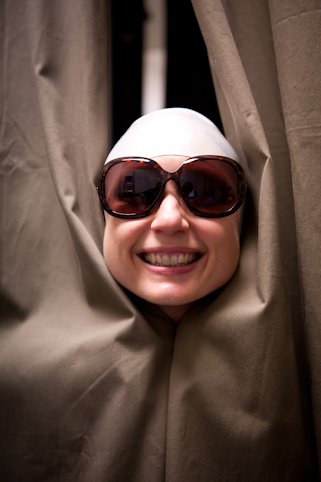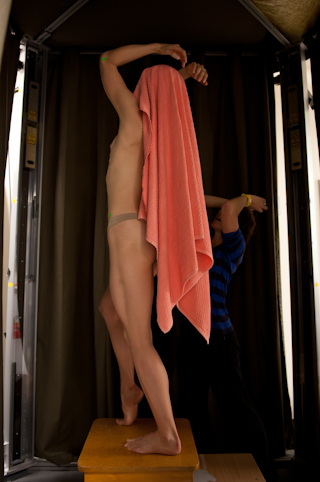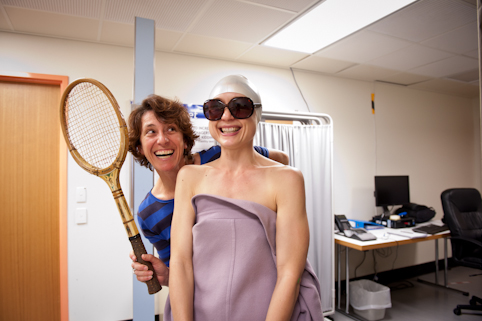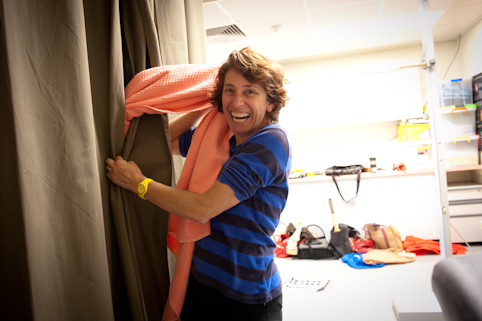HLP Day Five :: Uni SA anthropometric scanning
 Monday, October 10, 2011 at 11:54PM
Monday, October 10, 2011 at 11:54PM Today we worked at the University of South Australia's Health Sciences Department, working with Thomas Bowler, Project Coordinator, using their anthropometric scanner. I really wanted to keep this part of the project as open as possible, because it is hard to know what to expect from this kind of technology in terms of how it intersects with what we are exploring, and because it's the unknown element that makes it interesting. We went into the 'lab' with just a simple plan to try a few of the moments from our current choreography in the scanner, which takes around 10 seconds to complete a 3D scan of the body. The fact that Lisa had to be able to hold a pose for this long provided a limitation for what we could select, and this was welcomed as an interesting challenge to how we worked. The scanner also has a fixed 'footprint' which restricts the 'size' (width, depth, height) of what the subject can do in the scanner - and this provided us with another interesting challenge. At times we did have to modify the pose to fit. Because of the flexibility of how we are working, we resolved that if we do want to link the scanned 3D file to our moving image work, we could easily modify the nuances of the movement to better interact with the 3D scan. Lovely.
 Lisa peers out of the scanner to view the resulting image on the monitor You can see from the image here that Lisa needed to wear a swimming cap in the scanner - this was to avoid the complexity of detail in hair that can create artifacts in the image. The glasses were a 'wardrobe' choice - nothing to do with the lasers that allow the image to be captured. The 'traditional' pose of the human subject in the scanner was hugely challenged, with Carol creating poses that Tom, who was operating the scanner and supporting us with our project for the day, had never seen in the scanner before. We used props for many of our images, and they offered another dimension altogether. I think we broke most of the rules about how to create a 'successful' 3D anthropometric image, going rather for an 'interesting' image. I became more and more interested in the opportunities for adding movement to the resulting files by creating scan sequences that we can hopefully edit together in post.
Lisa peers out of the scanner to view the resulting image on the monitor You can see from the image here that Lisa needed to wear a swimming cap in the scanner - this was to avoid the complexity of detail in hair that can create artifacts in the image. The glasses were a 'wardrobe' choice - nothing to do with the lasers that allow the image to be captured. The 'traditional' pose of the human subject in the scanner was hugely challenged, with Carol creating poses that Tom, who was operating the scanner and supporting us with our project for the day, had never seen in the scanner before. We used props for many of our images, and they offered another dimension altogether. I think we broke most of the rules about how to create a 'successful' 3D anthropometric image, going rather for an 'interesting' image. I became more and more interested in the opportunities for adding movement to the resulting files by creating scan sequences that we can hopefully edit together in post.
As I write I am struggling to download a player that will allow me to view the AVI files we created from the scans. DivX installers are not recognised, so I am now trying VLC media player. I am still not sure how these images might be used, if at all, but it was a really interesting day - partly because of the physical and practical restrictions that were placed on how the movement was interpreted, and because of the process of inspecting a position from a variety of angles compositionally and spatially.
The most poignant thing for me as a photographer was the idea of how we assume so much about perspective, and perspective choice. How a particular compositional idea can be so incredible from one position and so completely unexpected from another - even though we live and experience a 3D world in such a dynamic way, and know academically how an object will probably appear from another angle because of the sum of our experience of that object / shape and it's interaction with it's environment. The body shadowing itself was an interesting phenomenon to consider. We usually welcome and embrace shadows for adding dimension to images- in this case the shadows become a source of information denial to such a degree that they are avoided. Needless to say we welcomed the shadows in our 3D images. Probably not technically sophisticated results from a University perspective, but creatively a lot of fun for us to play with.
 One of the poses we introduced in our 'freeplay' session
One of the poses we introduced in our 'freeplay' session  retaliation - Carol & Lisa between scans
retaliation - Carol & Lisa between scans Carol Wellman Kelly - facilitating an interesting scan I have now managed to get the AVI files to play using the VLC player and OOPS - something I didn't consider is the portrait orientation of the file - of course! Hmm, I may need to think about that! We were very excited that one of the view options for the files included a grid (this makes sense - they are data-based images used for measurement and information). This may be the only time a true anthropometric grid is used in this project, so it was embraced.
Carol Wellman Kelly - facilitating an interesting scan I have now managed to get the AVI files to play using the VLC player and OOPS - something I didn't consider is the portrait orientation of the file - of course! Hmm, I may need to think about that! We were very excited that one of the view options for the files included a grid (this makes sense - they are data-based images used for measurement and information). This may be the only time a true anthropometric grid is used in this project, so it was embraced.
In closing, I just need to say that the university of South Australia has been amazing in providing this experience and the resulting images for our project as sponsors, and they have been absolutely amazing! Tom was not at all phased about us trying any of our ideas and totally supportive of our quirky and random processes. Grant Thomkinson, who has been our main contact with the Department of Health Sciences at Uni SA, has also been brilliant and very professional. We are so grateful to them for their support!!
Tomorrow :: Hoping to install a 'stage' that Peter Stanley has magically created for us, and LOTS more work with the choreography.
Reader Comments (2)
I have to comment about the 3D scanner experience 1) because I was the only creative that has experienced from the inside and 2) 60 odd incredably still scans later my body feels like I have been in a train crash. Holding still is really dynamic on the muscles, especially in extreme or twisted positions and the saying comes to mind 'the silence is defening' is like 'the stillness is painful' - a new quote to add to that list. This process so far is unique in my experience in dance film making. The focus is not purely on the dance or form but is a combination of many elements- that is the technology, environment or set, the lighting, building these Minitures up with the constant forthought for how it may be realized in the editing room. Then the component bringing all these elements into the room is our subject of study, our question of investigation. Thinking about it tonight- I feel essentially we are playing with the moving body in a single frame- warping and stretching time like we are wizards. We have dressed these characters to offer the viewer a reference point or a personality or character they can hook in to or perhaps relate to. Some characters will appeal to some more then others- similar to walking through a gallery. Some people will stop and look at one painting more closely whist another person will just give it a glance. We are trying to draw our viewer in and offer a curiosity just like Muybridge does with his photo's. But in our case we want to take it further and transform these photos in front of the viewer's eyes...like the wizards we are trying to be. Perhaps only visual mediums can really do this and this is why they are so satisfying to work with. Muybridge was sick with a mental illness prior to his later studies. These later studies are far more dramatic. Some are quite bizarre. The point I am trying to arrive at is that the ghost of Muybridge is with us perhaps. And for those that may
brave the same investigation- such as playing with time and perspective- cant help but go a little bit mad and confused.Although it is completely fascinating to us it is beyond our real understanding. I think I have to go to bed!
Lisa, I can't imagine what it must have been like in that scanner! Maybe Carol and I should have jumped in to share the experience? You did a really amazing job. You have such amazing diligence and focus - very impressive. Hope you are recovering..
All this precision must be making you want to just leap about with wild abandon to escape the rigour..but hopefully it's all worth it! It's so great working with you :)